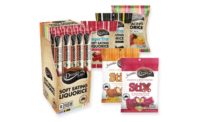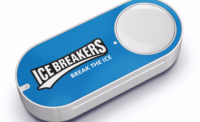Sugar-free sales are a huge slice of the confectionery market, and candy makers are happy to meet the demand.
Many think of candy as an extra, a treat, something you don’t overindulge in. Candy isn’t actually food—right? So it doesn’t have to be healthy—right? Well, it can be and it increasingly is. As the world grows more obsessed with watching what’s in their food and how much of it they eat, licorice manufacturers are listening and, more importantly, responding.
This is exactly the trend that Morris National has been working to address along with a demand for easier-to-chew licorice, says Rich Clemmensen, v.p. of sales and marketing at Morris National.
The company has been importing Australian, soft-eatingCapricorn Liquorice into Canada for a number of years now. The sticks come in traditional and strawberry flavors. Morris National became the exclusive importer of the brand to the United States at the end of 2013.
“Capricorn is the softest eating licorice you will ever taste. The motivation was to replicate the success in Canada to the U.S.,” Clemmensen says.
As for the healthy aspect, Clemmensen says Morris National is not taking the trend lightly. On top of offering all natural color and all natural flavored licorice, the company takes an aggressive approach to being transparent, exceeding efforts by multinational confectionery companies.
According to Clemmensen, licorice consumers want help controlling their portion sizes and they’re using the FDA recommended labeling. “You’ll notice on all the packages that we’re using those calories per serving on the front panel just to help the consumer manage their diet.”
Another Australian licorice company, Darrell Lea, is also all about soft licorice and offers all-natural licorice products with no preservatives.
Moreover, soft-eating licorice is experiencing such a major growth spurt that supplying the demand to the United States has become Darrell Lea’s biggest challenge. The company is throwing at least $80 million into addressing that, according to Don Cook, president at International Food Associates, the U.S. representative for Darrell Lea.
“In answer to this challenge they are currently building a new first class manufacturing facility to update machinery and meet the expanding demand,” Cook says.
The move is set to commence around Easter.
While Darrell Lea is connecting health to the natural idea, American Licorice Co. is approaching health from the perspective of portion size.
The company, whose most recent licorice launch was the Grape Vines brand at least two years ago, has just launched Fruit Vines Bites. An off-shoot of their well-known Red Vines brand, it is a soft, chewy, bite-sized candy that comes in cherry and strawberry flavors.
From the makers of Red Vines, Fruit Vines Bites are not just healthier because they are smaller than a long strand of licorice. “Some of the top trends that [consumers] are looking for are low fat as well as no preservatives. So that’s ultimately what guided us in our formulation,” says Stephanie Louie, brand manager at American Licorice.
The brand just started shipping on Jan. 2. so it’s fresh off the line and out the door, according to Louie, who says the bites will be available at major retailers including Kroger, Wal-Mart, Target and Walgreens.
The smaller portion idea is not exclusive to American Licorice. Morris National agrees that smaller pieces are a good way to address health. The thought is that eating smaller bits will amount to eating less.
That’s why this month, the company is launching Tangy Zangy Twisties in sour wild berry and Tangy Zangy Squares in sour wild fruit flavor. Both flavors already exist in a longer stick form.
Tangy Zangyis not a little kid “blow your head off” sour as are many sour candies in the confectionery industry, Clemmensen says. “It’s a refreshing sour for the whole family and I think that’s worked well for the brand.”
Clemmensen says licorice is consumed by all ages, which is why they’ve thought hard about making it family friendly and have not targeted a specific age group. While the naturalness of the Capricorn brand might appeal more to adults, the Tangy Zangy bite-size is more fun for kids with its sour flavor while providing moms with portion control.
Dan Mohnshine, senior brand manager at Twizzlers, agrees that licorice has the interest of the entire family. “Consumers of all ages are enjoying licorice. Thirty- or forty-something adults are buying licorice in the store with the intent to share it with others in their household.”
However, bite-size is more about convenience than health for the Hershey Co. brand, which launched Twizzlers Filled Bites in 2013. The poppable pieces of licorice offered small to customers in an innovative way. “Our Twizzlers Filled Bites product launch, which was very successful, was grounded in insights about consumers wanting more on-the-go, bite-sized options,” Mohnshine says.
On top of coming in small pieces, the bites come in a resealable pouch and Twizzlers sees confectionery convenience continuing to grow in 2014. The Filled Bites were named National Confections Sales Association’s global new product of the year in the non-chocolate category for 2013.
Another company interested in bite-sized and innovative flavors is Darrell Lea. The company currently has chocolate-covered soft licorice bites in blueberry-pomegranate with dark chocolate and strawberry with milk chocolate.
It is considering a launch of traditional black licorice enrobed in milk chocolate, but a decision hasn’t been made yet, says Cook. Such a product is important to the company because they are looking to meet the demands of the increasingly active U.S. lifestyle through on-the-go small sizes, akin to what The Hershey Co. is doing.
One trend that hasn’t changed is that licorice remains an impulse buy, says Cook, who emphasizes how products are merchandized on the shelf and within a store are important for success, no matter what the more contemporary trends.
“With that said, floor displays, end caps, clip strips, cash register positioning, all help to make this product stand out from all the other food and candy items,” Cook says.
It certainly can stimulate a healthy impulse.











.jpg?height=200&t=1708365084&width=200)
